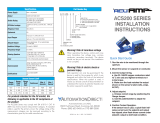Page is loading ...

IN ORDER TO AVOID ELECTRIC SHOCK OR OTHER POSSIBLE INJURY:
• DO NOT USE THIS PRODUCT FOR HUMAN SAFETY APPLICATIONS.
IT WAS NOT DESIGNED, TESTED OR RECOMMENDED FOR THIS
USE.
• DO NOT USE THIS PRODUCT IN HAZARDOUS LOCATIONS (E.G.
EXPLOSIVE ATMOSPHERES). IT WAS NOT DESIGNED, TESTED OR
RECOMMENDED FOR THIS USE.
• ENSURE THE PRODUCT IS PROPERLY WIRED FOR THE
APPLICATION. REFER TO THE SPECIFICATIONS AND WIRING
DIAGRAMS IN THIS MANUAL.
MODELS COVERED IN THIS MANUAL
Catalog Number Description
ECSNOASC Self-Powered, Solid Core, N.O., Adjustable Setpoint (1-150A), LED
ECSNOFSC Self-Powered, Solid Core, N.O., Fixed Setpoint (1.0A), No LED
ECSNCASC Self-Powered, Solid Core, N.C., Adjustable Setpoint (1-150A), LED
ECSNCFSC Self-Powered, Solid Core, N.C., Fixed Setpoint (1.0A), No LED
ECSNOASP Self-Powered, Split Core, N.O., Adjustable Setpoint (1.75-150A), LED
ECSNOFSP Self-Powered, Split Core, N.O., Fixed Setpoint (1.5A), No LED
ECSNCASP Self-Powered, Split Core, N.C., Adjustable Setpoint (1.75-150A), LED
ECSNCFSP Self-Powered, Split Core, N.C., Fixed Setpoint (1.5A), No LED
INTRODUCTION
The Cutler-Hammer
CurrentWatch™ ECS Series are
a family of self-powered, solid-
state current-operated switches
which trigger when the current
level sensed through the
aperture exceeds the adjusted
setpoint. The solid-state output contacts can
switch AC or DC, making the ECS Series well
suited for applications in automation systems.
Eaton’s current sensor family encompasses a broad range of products
for cost-effective monitoring, status, and predictive maintenance.
Downtime and costly repairs can be avoided by utilizing Eaton’s
products and technologies in your control systems.
Installation Instructions
CurrentWatch™ ECS Series Current Switch
AC Current Switch, Fixed or Adjustable Setpoint
INSTALLATION
Considerations for all ECS Series models…
• Run wire to be monitored through the aperture (opening) in the
switch body
• These switches can be located in the same environment as
motors, contactors, heaters, pull-boxes and other electrical
enclosures
• Mounting can be done in any position or hung directly on wires
with a wire tie
Considerations for split core versions (-SP suffi x)…
• To open the switch, press the tab inward (toward the body of the
switch) as shown below
• After placing the wire in the aperture, press the hinged portion
fi rmly downward until a click is heard and the tab pops out fully
• Keep the contact areas of split-core switches clean at all times
QUICK INSTALL GUIDE
The below steps can be followed to quickly install a CurrentWatch™
ECS Series switch.
1. Run the wire to be monitored through the aperture
2. Mount the switch
3. Connect output wiring
a. Use up to 14 AWG copper wires
b. Use caution not to exceed solid state output rating (see
specifi cation table on following page)
3. Adjust the setpoint
a. Use the potentiometer to adjust the setpoint
LED / OUTPUT STATUS TABLE
Monitored Amps
Output
Smart-LED
(If Present)N.C. N.O.
None or Minimum Closed Open Off
Below Trip Level Closed Open Slow (2 sec.)
Above Trip Level Open Closed Fast (0.5 sec.)
P51916 Rev 02
Effective: January 2008 Page 1
WARNING
Questions? Call our Sensor Application Engineers at (800) 426-9184.
To open:
Press tab inward
towards hinge
Important:
Keep contact areas clean
392500221

P51916 Rev 02
Effective: January 2008 Page 2
Questions? Call our Sensor Application Engineers at (800) 426-9184.
RANGES AND MAXIMUM AMPS
Housing
Style Setpoint Outputs
Maximum Input Amps
Continuous 6 sec. 1 sec.
Solid Core Fixed (1.0A) N.O. 250A 400A 1,000A
N.C. 150A 400A 1,000A
Adjustable (1-150A) N.O. 150A 400A 1,000A
N.C. 150A 400A 1,000A
Split Core Fixed (1.5A) N.O. 250A 400A 1,000A
N.C. 150A 400A 1,000A
Adjustable
(1.75-150A)
N.O. 150A 400A 1,000A
N.C. 150A 400A 1,000A
SETPOINT ADJUSTMENT
The CurrentWatch™ ECS Series setpoint is adjusted with a four-turn
potentiometer (for models ending -SP) or a fi fteen-turn potentiometer
(for models ending -SC). The pot is shipped factory set to the lowest
setpoint, fully clockwise. Turning the pot counter-clockwise will increase
the setpoint. The pot has a slip-clutch to prevent damage at either end
of its rotation. To determine where the adjustment is, turn the pot all the
way clockwise. This will return it to the minimum setpoint.
Important Setpoint Adjustment Notes
• Output contacts are solid-state. Check output status by applying
voltage to the contacts and reading the voltage drop across the
contacts. An Ohmmeter set on “continuity” will give misleading
results.
• It is recommended the setpoint be adjusted to allow for voltage
variations of 10 to 15 percent.
• Mounting can be done in any position or hung directly on wires
with a wire tie
Typical Adjustment Steps
1. Turn the pot to the minimum setpoint (four or fi fteen turns
clockwise).
2. Have normal operating current running through the switch. The
output should be tripped since the pot is at its minimum setpoint.
For units with an LED, it should be fl ashing fast (two to three times
per second).
3. Turn the pot counter-clockwise until the unit un-trips. This is
indicated by the slow fl ashing of the LED (once every two to three
seconds), or by changing of the output switch status.
4. Now turn the pot clockwise slowly until the unit trips again. It is
now set at the current level being monitored.
a. To set underload, turn the pot about 1/8 turn further clockwise
b. To set overload, turn the pot about 1/8 turn further counter-
clockwise
WIRING DIAGRAM
Connect control or monitoring wires to the sensor. Use up to
14 AWG copper wire and tighten terminals to 5 inch-pounds torque. Be
sure the output load does not exceed the switch rating.
CAUTION! Incandescent
lamps can have “cold
fi lament inrush” current
of up to ten times their
rated amperage. Use
caution when switching
lamps.
TROUBLESHOOTING
Problem Solution
Switch is
always tripped
The setpoint may be too low. Turn the pot counter-clockwise to
increase the setpoint.
The switch may have been overloaded and the contacts are
burned out. Check the output load, remembering to include inrush
on inductive loads (coils, motors, ballasts).
Switch will
not trip
The setpoint may be too high. Turn the pot clockwise to decrease
the setpoint.
On split core models, the core contact area may be dirty. Open the
switch and clean the contact area.
The monitored current may be below the minimum required. Loop
the monitored wire several times through the aperture until the
“sensed” current rises above the minimum. The sensed amps
equals “actual amps” multiplied by the “number of loops.” Count
loops on the inside of the aperture.
The switch may have been overloaded and the contacts are
burned out. Check the output load, remembering to include inrush
on inductive loads (coils, motors, ballasts).
SPECIFICATIONS
Solid Core Split Core
Power Supply Self Powered–No Power Supply Needed
Output Magnetically Isolated Solid-State Switch
Output Rating Normally Open Models: 0.15A, 240V AC/DC
Normally Closed Models: 0.20A, 135V AC/DC
Off-State Leakage < 10 µA
Response Time 120 ms
Adjustable Setpoint Range 1-150A 1.75-150A
Setpoint Adjustment 15-Turn Potentiometer 4-Turn Potentiometer
Fixed Setpoints 1.0A 1.5A
Hysteresis Approximately 5% of Setpoint
Overload Fixed Setpoint, N.O. Models: 6 sec. @ 500A; 1 sec. @ 1,000A
All Other Models: 6 sec. @ 400A; 1 sec. @ 1,000A
Isolation Voltage UL Listed to 1,270V AC, Tested to 5,000V AC
Frequency Range 6-100Hz
Sensing Aperture 0.74 in. (19mm) 0.85 in. (21.6mm)
Housing UL94 V0 Flammability Rated
Environmental Operating Temperature: -58 to +122° F (-50 to +50° C)
Humidity: 0-95% RH, Non-Condensing
Approvals UL and ULC Listed
CE Certifi ed
392500221
AC or DC
Power
AC or DC
Load
Monitored Wire
Current Switch
Use caution when
switching lamps
/



